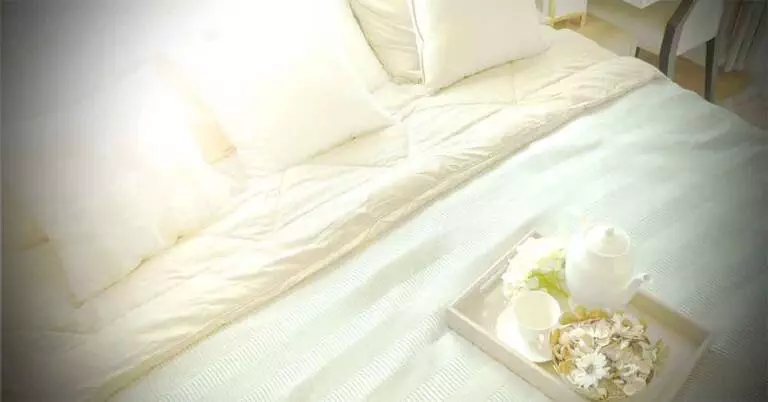Why Do Pillows Go Flat: How to Keep Pillows Fluffy and Comfortable
Have you noticed that your once fluffy and supportive pillow has gone flat over time? It’s frustrating, leaving you feeling tired and achy all day long. But why do pillows go flat in the first place?
There are a few reasons pillows lose their shape and support over time, from the materials used to make the pillow to how you use and care for it.
If you’re tired of tossing and turning on a flat pillow, read on to find out why it happens and what you can do to prevent it.
Why Do Pillows Go Flat So Fast?
There are several reasons why pillows go flat. The most common cause is compression from regular use.
- Filling inside the pad compresses and loses its ability to provide support. This can happen with any filling, including down, feathers, foam, and polyester.
- The pillow cover or casing may become worn or stretched out, allowing the filling to shift and clump together.
- Sleeping habits and positions can also affect how quickly a cushion goes flat, as some positions put more pressure on the pad and cause it to compress more rapidly.
- Inadequate care may also lead to a flat headrest. If you don’t regularly wash or fluff your bedding, dust mites and other allergens can accumulate in the stuffing and reduce its loftiness.
- The age of the cushions can also play a role, as older pads are more likely to lose their shape and support over time.
All cushions will eventually flatten out over time. And typically, low-quality pillows may lose their firmness and get flat more quickly than higher-quality ones.
Why Is Sleeping on a Flat Pillow a Problem?
A flat cushion can impact your sleep as it loses its ability to support your neck and head properly:
- Sleeping on a flat headrest may lead to poor spinal alignment and neck pain.
- A flat cushion no longer provides adequate support for the head and neck, which can cause these areas to be strained or twisted during sleep.
- Discomfort can cause you to toss and turn throughout the night, disrupting your sleep and leaving you tired and groggy in the morning.
- This can result in discomfort and even long-term damage to the spine and surrounding muscles.
- A flat headrest may not provide enough elevation for the airways, which can contribute to snoring or sleep apnea.
It’s essential to replace your cushion when it starts to go flat to ensure you get the support you need for a good night’s sleep.
How to Fluff Your Flat Cushion?
To fluff a flat cushion, you can try several methods:
1. Fluffing by hand: Grab the corners and vigorously shake it to redistribute the filling.
2. Beating: Lay the pad flat on a surface, and hit it with a clean bat or tennis racket to loosen and fluff the filling.
3. Using a dryer: Place the cushion in the dryer with clean tennis balls or dryer balls. Set the dryer to a low heat setting and tumble for 15-20 minutes.
4. Vacuuming: use a vacuum cleaner with an upholstery attachment to suck out any dust, dirt, or moisture that may be weighing down the pad.
5. Sunning: Place the cushion outside in the sun for a few hours. The heat and fresh air can help to fluff it up.
6. Adding filling: You may need more filling if your cushion is very flat. You can purchase more stuffing or use an old pad to add more filling.
7. Rotate often: Rotate your cushion daily so the same areas aren’t under pressure each night.
Regularly washing and drying your cushion can help maintain the fluffiness.
Finally, if your headrest is old and worn out, it may be time to replace it with a new pillow.
Which Types of Pillows Don’t Go Flat Easily?
Some materials are less likely to go flat quickly.
1. Memory foam: Memory foam pillows are made from a dense and supportive material that conforms to your head and neck shape, providing consistent support and preventing flattening.
2. Latex: Latex pillows are made from a natural or synthetic rubber material that is resilient and durable, meaning they can withstand the weight of your head and maintain their shape over time.
3. Buckwheat: Buckwheat pillows are filled with small buckwheat hulls that can be adjusted to conform to your desired shape and provide support without flattening.
4. Down alternative: Down alternative is a synthetic materials that mimics the softness and support of down feathers without the risk of flattening over time.
These materials don’t go flat easily because they are designed to provide consistent support and maintain their shape over time.
What About Cotton and Polyester? Do They Get Flat?
Cotton pillows can go flat because cotton is a soft and compressible material. Over time and with use, the cotton fibers can become compacted and lose their fluffiness, resulting in a flat, hard pad.
Polyester pillows tend to go flat faster than other synthetic materials, such as memory foam. The filling in polyester pads can compress and lose shape, leading to a flat and uncomfortable headrest.
The best type of pillow for you will depend on your preferences and sleeping habits.
Read more: Polyester vs. Cotton Pillow (9 Differences You Should Know!)
How Do You Fluff a Compressed Pillow?
Pillows are often sold tightly packed (compressed) into a thin package. These vacuum-sealed space-savers are usually made from foam, feathers, wool, latex, or synthetic materials. So, how to expand it from its compressed form:
- Open the compact plastic package with scissors.
- Start to massage and pat the pad. Push in and out evenly on all sides. The parts of the filling have become tangled, so you need to break them off evenly.
- If these don’t help, put the pillow in the dryer on a low heat setting with a couple of clean tennis balls or dryer balls. This will help to break up any clumps and redistribute the filling, making it fluffier.
How to Make Your Cushions Stay Fluffy Longer
Some ways to make your cushions last longer without going flat over time include:
1. Fluffing them regularly: This helps redistribute the filling and prevent it from becoming compressed in certain areas.
2. Using a pillow protector: A protector can help keep your cushion clean and free from dust and sweat, which can break down the filling over time.
3. Choosing the right filling: Different types of fillings have different levels of durability. For example, down feathers may be more comfortable but may not last as long as synthetic or memory foam fillings.
4. Be mindful with machine washing: Some pads can safely be machine-washed, but washing can also cause the filling to clump and lose shape. To be safe, spot clean stains and air dry.
5. Using multiple pillows: By alternating between different headrests, you can give each one a chance to fluff back up and recover from compression.
It also helps to avoid using the cushions for activities other than sleeping, such as sitting or playing games.
Don’t store your bedding in a place with high humidity or direct sunlight, which may cause fibers within the buffer to break down faster.
Maintaining fluffiness is essential for getting a good night’s sleep. Investing in high-quality bedding made from durable materials can extend its lifespan.
How Long Do Pillows Last?
The lifespan of a cushion depends on various factors, such as the quality of the material, the frequency of use, and the care taken to maintain it.
Generally, synthetic pillows can last anywhere from 1 to 3 years. Down and feather can last significantly longer (the fill is durable and can be washed regularly).
However, if the pad has gone flat and no longer provides adequate support or comfort, it may be time to replace it.
Tips for Determining When to Replace Your Pillow
It’s time to replace your headrest when it no longer provides adequate support and comfort for your head and neck while sleeping.
Signs that your cushion has gone flat and needs to be replaced include:
- Waking up with neck or shoulder pain.
- Experiencing poor sleep quality.
- Noticing visible signs of wear and tear, such as flattened or lumpy areas.
It’s generally recommended to replace your cushion every 2 years or sooner, depending on your usage and type of bolster.
But there is no consensus on how often people really do replace their pads. It is probably much more than the recommended time.
How Can I Tell If My Pillow Is Flat?
So how can you tell if your headrest has gone flat? Does it look much thinner than when you bought it? Has its shape changed over time? When you place it on a flat surface, does it maintain its shape or collapse?
You can also fold the pad in half and see if it bounces back to its original shape or remains crumpled.
Is your headrest lumpy or uneven? Do you find that fluffing doesn’t help? If so, chances are that it’s gone flat.
You may also notice that you’re waking up with a sore neck or shoulders, which can be attributed to the lack of support from your headrest.
Note that even if your cushion looks fine outside, it doesn’t necessarily mean it provides adequate support inside.
Don’t wait until you feel uncomfortable in bed before checking if your headrest has gone flat!
The Bottom Line
There are several reasons why cushions go flat over time, but the good news is that there are also several ways to revive them.
To ensure a good night’s sleep, either fluff and rotate your pillow or consider purchasing a high-quality replacement.
Don’t let a flat pillow ruin your sleep – take action and enjoy sweet dreams!

